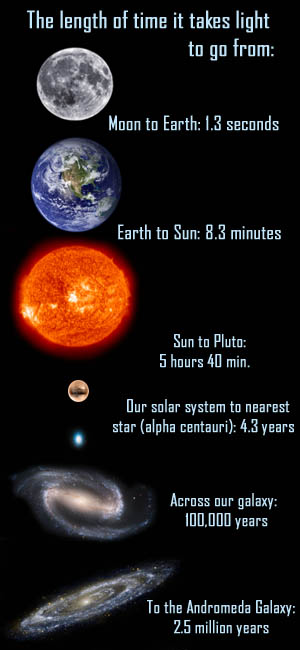The Speed
of 
 Light travels at a speed of 186,000 miles a second or 700 million
miles an hour. For scale, the distance from the Earth to the Moon
is about 239,000 miles. This seems pretty fast and indeed theory
says that nothing can travel faster than the speed of light.
Light travels at a speed of 186,000 miles a second or 700 million
miles an hour. For scale, the distance from the Earth to the Moon
is about 239,000 miles. This seems pretty fast and indeed theory
says that nothing can travel faster than the speed of light.
In our every day lives light seems to travel from
one place to another instantaneously. When we flip on the light
in a room there is no delay between when we first see the bulb
start glowing and when light illuminates the far corners of the
chamber. Our nervous systems are much too slow to notice the rays
of light that appear from the bulb and move like a wave washing
over the room.
When we deal with the immense distances of space,
though, even light seems slow. When astronauts were on the Moon
it took over a second for the radio waves (which travel at the
speed of light) carrying their voices to reach us. Light coming
from the sun takes eight and one half minutes to hit Earth. (This
means that if the sun were suddenly to go dark, it would take
over eight minutes for us to notice) Light from the nearest stars,
other than the sun, takes four and a half years to get here. From
the farthest stars in distant galaxies it can take billions of
years for the light to arrive..
The distance light can travel in a year is called
a "light year." The light year is one of the basic measures of
distance for astronomy.
When designing probes for trips to other planets
in our solar system it is important for the planners to keep the
communications time lag, caused by the speed of light, in mind.
For example, a probe designed to land on Mars must be smart enough
to handle problems in the flight on its own without instructions
from Earth. If a course change is needed during landing the probe
would have to do it automatically. The delay caused by the probe
requesting instructions from Earth and getting commands back might
be nearly an hour, plenty of time for the probe to crash.
The delay caused by the speed of light can sometimes
be noticed here on Earth during telephone calls. Long distance
calls that have been routed over one or more space satellites
may cause a half second or so delay between the speaker and the
listener.
The speed of light has several properties which
may seem counter-intuitive to us, but are true:
-Nothing travels faster than the speed of light.
-No matter how fast you are moving the speed
of light seems to be the same speed as if you were not moving
at all.
-As an object or person is accelerated toward
the speed of light time slows down for it/him.
This last property leads to the "twins" effect:
Twin brothers live on Earth. One brother takes a trip to a distant
star traveling at a high percentage of the speed of light. When
the twin returns he will be younger than his brother because for
him time slowed down during the trip.
This effect, called "time dilation," helps explain
why the speed of light is the same no matter how fast you are
going. As a traveler accelerates time slows down for him. This,
in turn, affects his measurements.

Copyright Lee Krystek
1996-2013. All Rights Reserved.




 Light travels at a speed of 186,000 miles a second or 700 million
miles an hour. For scale, the distance from the Earth to the Moon
is about 239,000 miles. This seems pretty fast and indeed theory
says that nothing can travel faster than the speed of light.
Light travels at a speed of 186,000 miles a second or 700 million
miles an hour. For scale, the distance from the Earth to the Moon
is about 239,000 miles. This seems pretty fast and indeed theory
says that nothing can travel faster than the speed of light.
